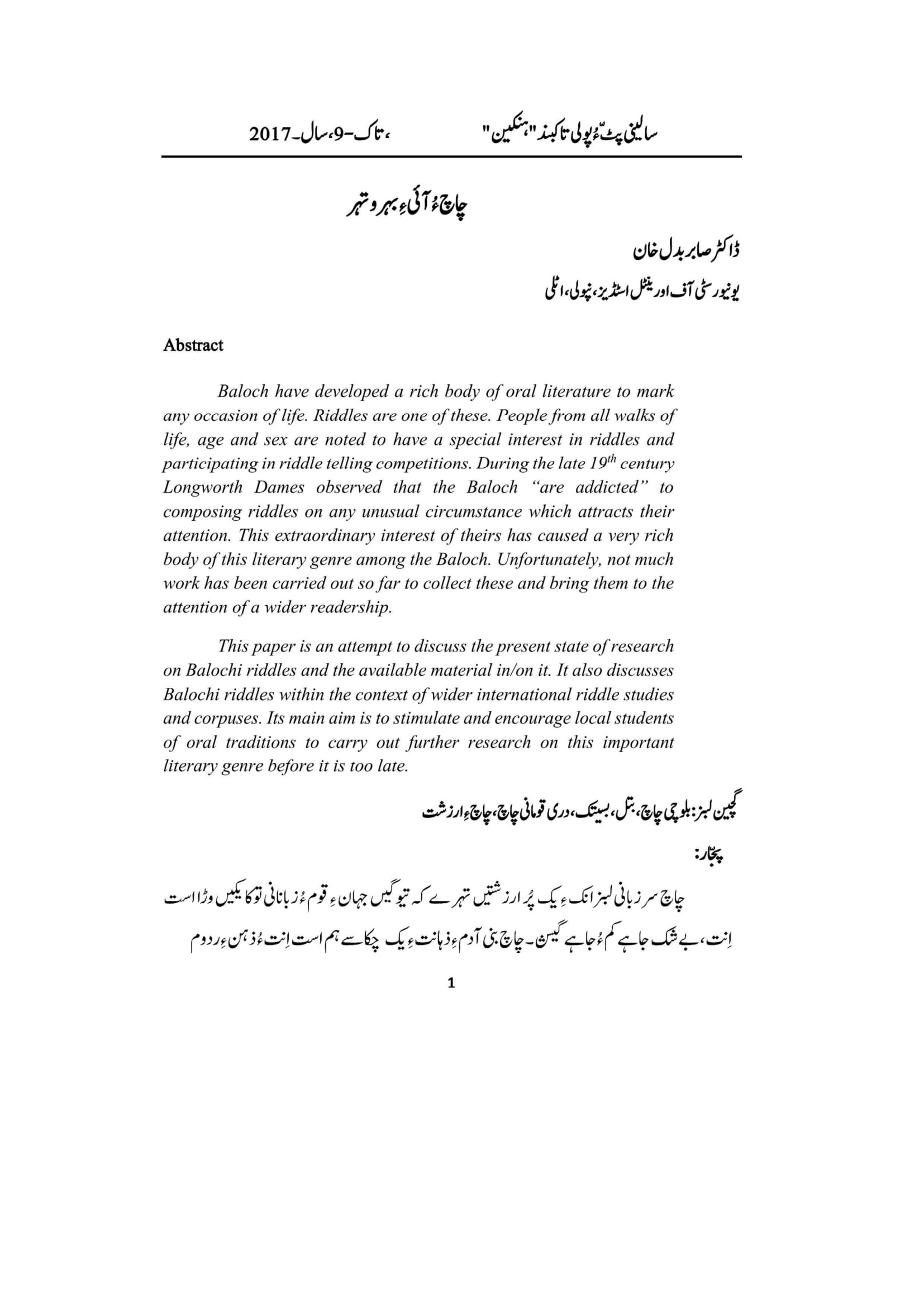چاچ ءُآئی ءِ بہروتہر
Riddles: its forms and kind
Keywords:
Balochi Enigme, idioms, Bastak, Importance of Enigme.Abstract
Baloch have developed a rich body of oral literature to mark any occasion of life. Riddles are one of these. People from all walks of life, age and sex are noted to have a special interest in riddles and participating in riddle telling competitions. During the late 19th century Longworth Dames observed that the Baloch “are addicted” to composing riddles on any unusual circumstance which attracts their attention. This extraordinary interest of theirs has caused a very rich body of this literary genre among the Baloch. Unfortunately, not much work has been carried out so far to collect these and bring them to the attention of a wider readership.
This paper is an attempt to discuss the present state of research on Balochi riddles and the available material in/on it. It also discusses Balochi riddles within the context of wider international riddle studies and corpuses. Its main aim is to stimulate and encourage local students of oral traditions to carry out further research on this important literary genre before it is too late.
References
غوث بخش صابر(1973)چاچ وبند:بلوچی اکیڈمی کوئٹہ
قدیرمجید(2013)چاچ گنج،سیدریفرنس لائبریری
Abbott, G.F., 1903 Macedonian Folklore, Cambridge University Press, Cambridge.
Abrahams, Roger D., 1980 between the Living and the Dead, Folklore Fellows Communications, vol. 225, Suomalainen Tiedeakatemia, Helsinki.
Ben-Amos, Dan, 1979 "Solutions to Riddles", in Chatman, S., Eco, U., and Klinkenberg, J. (eds.), A Semiotic Landscape: Proceedings of the First Congress of the International Association for Semiotic Studies, Milan, June 1974/Panorama sémiotique: Actes du premier congrès de l'Association International de Sémiotique, Milan, juin 1974, (pp. 1035-1038). Mouton, New York.
Bhagwat, Durga, 1965 The Riddle in Indian Life, Lore and Literature, Popular Prakashan, Bombay.
Dundes, Alan and Ved Prakash Vatuk, 1974 "Some Characteristic Meters of Hindi Riddle Prosody", Asian Folklore Studies, 33, 1:85-153.
Fussell, B. H., 1980 "The 'Neck Riddle' and Dramatic Form", New York Literary Forum, no. 5, pp. 161-71.
Elisa, Michael, 1995 "Neck-Riddles in Mimetic Theory", Contagion Journal of Violence Mimesis and Culture, 2(1):189-202.
Elisa, Michael, 1998 "Neck-riddles (AT 927): the two faces of the scapegoat", Summary Ph. D. Utrecht University 1998, Shaker Publishing, Maastricht.
Leather, Ella Mary, 1992 The Folk-Lore of Herefordshire: Collected from Oral and Printed Sources, published by Lapridge Publications, Hereford (first published in 1912 by Jakeman and Carver, Hereford). Norton, F. J. 1942 "Prisoner Who Saved His Neck with a Riddle", Folklore, Volume 53, no. 1, pp. 27-57.
Robert Rodriguez, 1998 "Riddle Me This and Riddle Me That", published in WIP, Winter 1998. Accessed on July 28, 2013 athttp://www.alanirvine.com/wip/robraves/riddle.htm. Rokem, Freddie, 1996 "One Voice and Many Legs: Oedipus and the Riddle of the Sphinx", in Galit Hasan-Rokem and David Shulman (eds), Untying the Knot: On Riddles and Other Enigmatic Modes, Oxford University Press, New York - Oxford, pp. 255- 270


